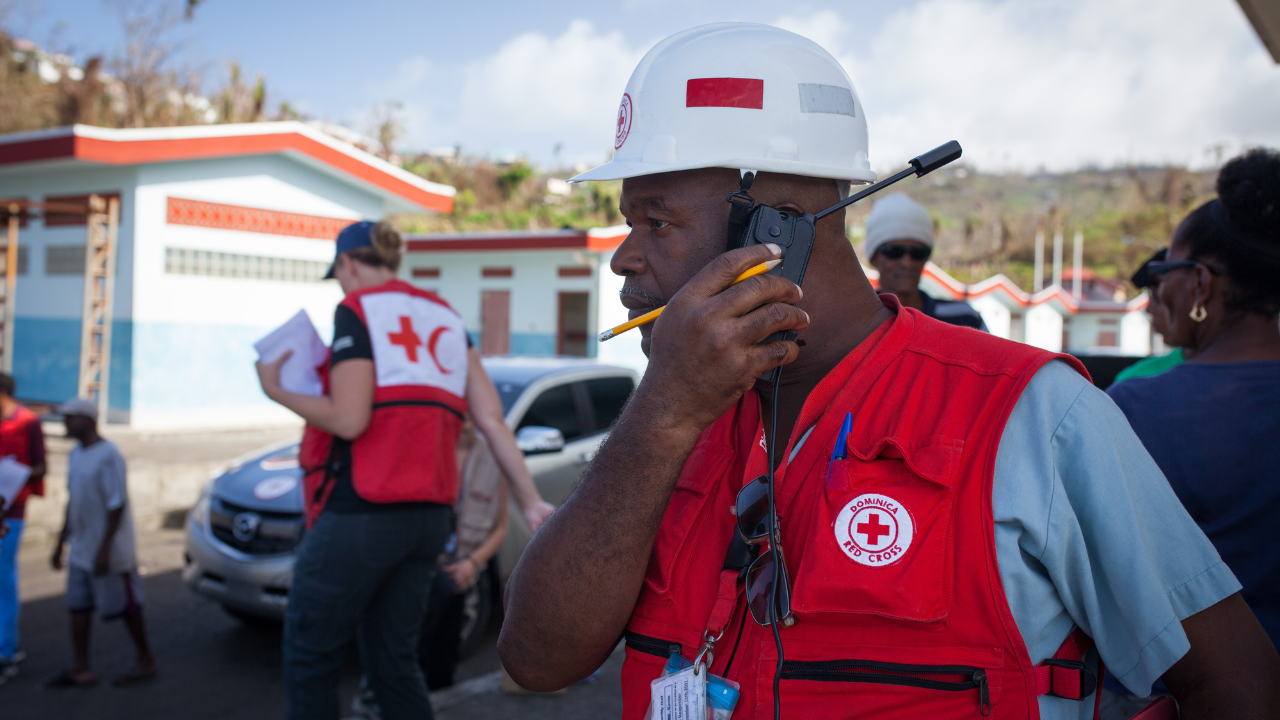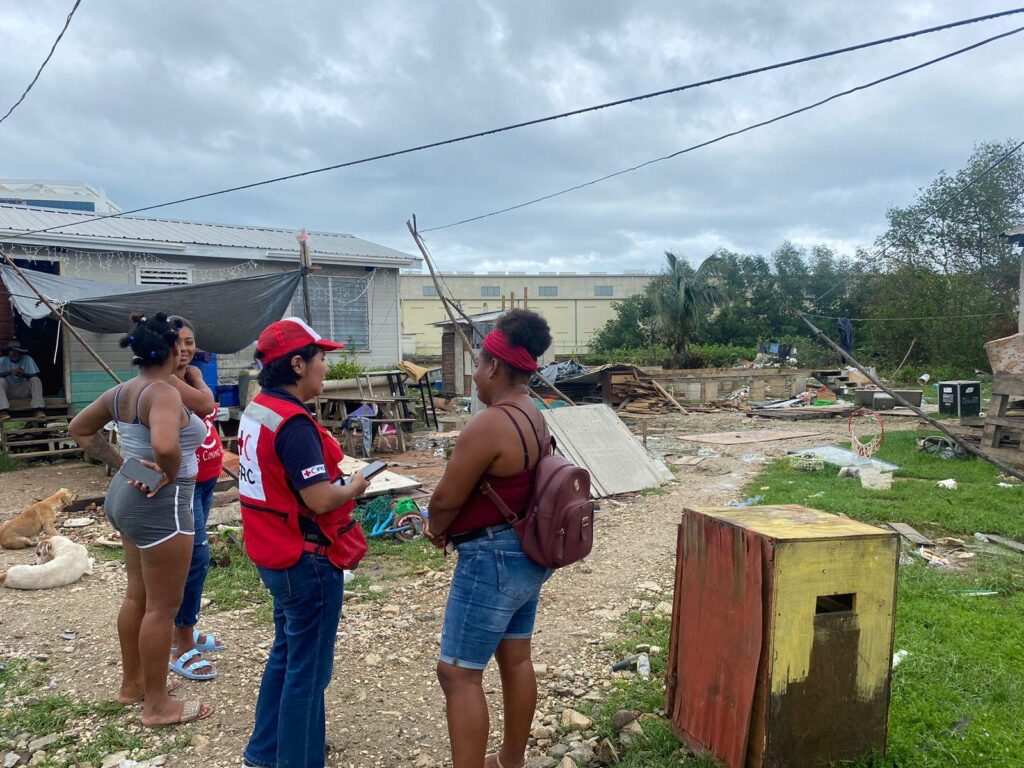
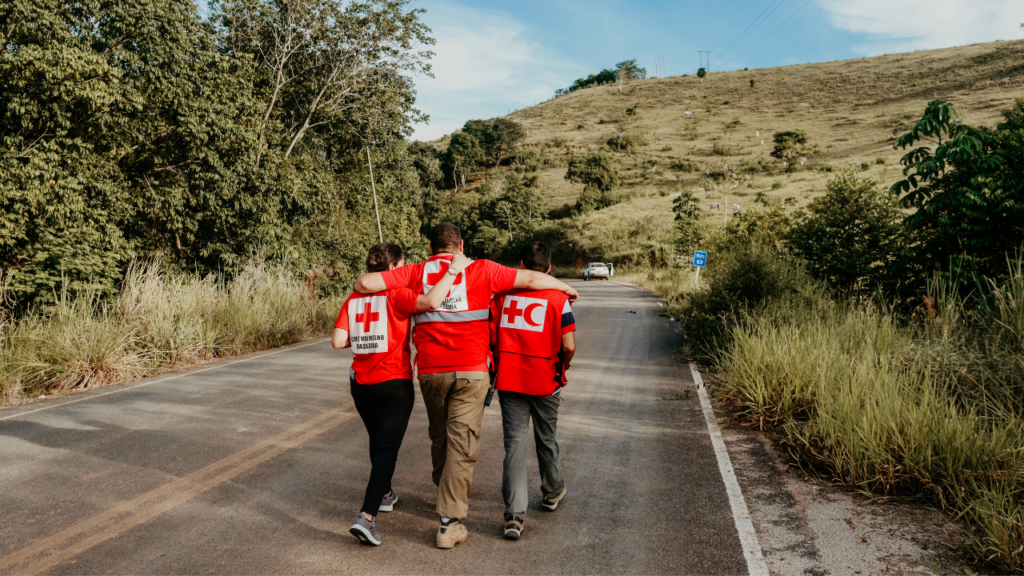
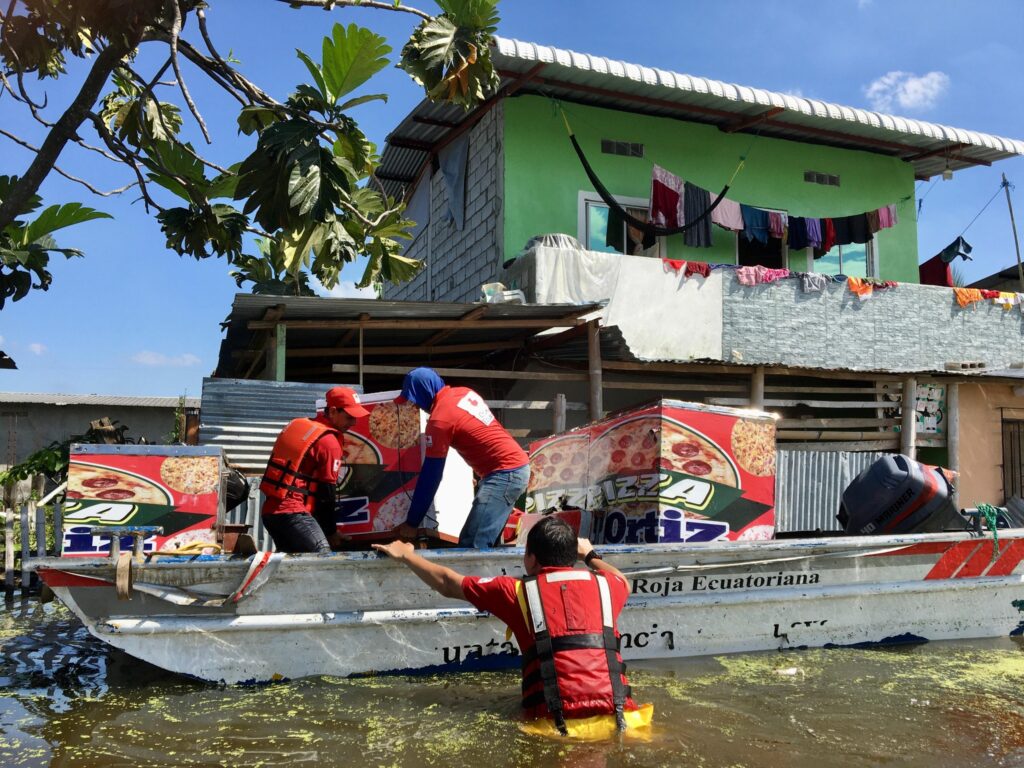
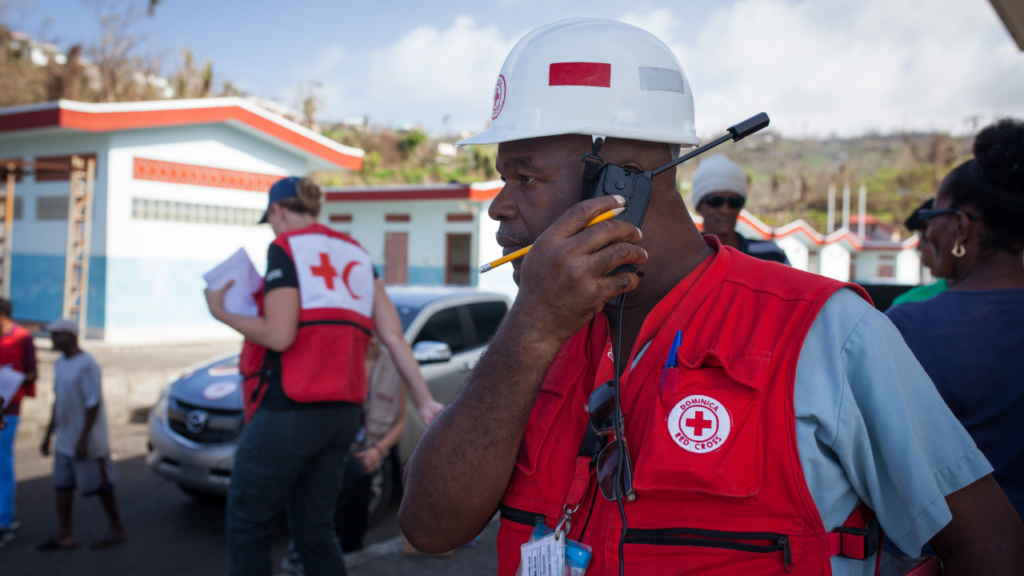
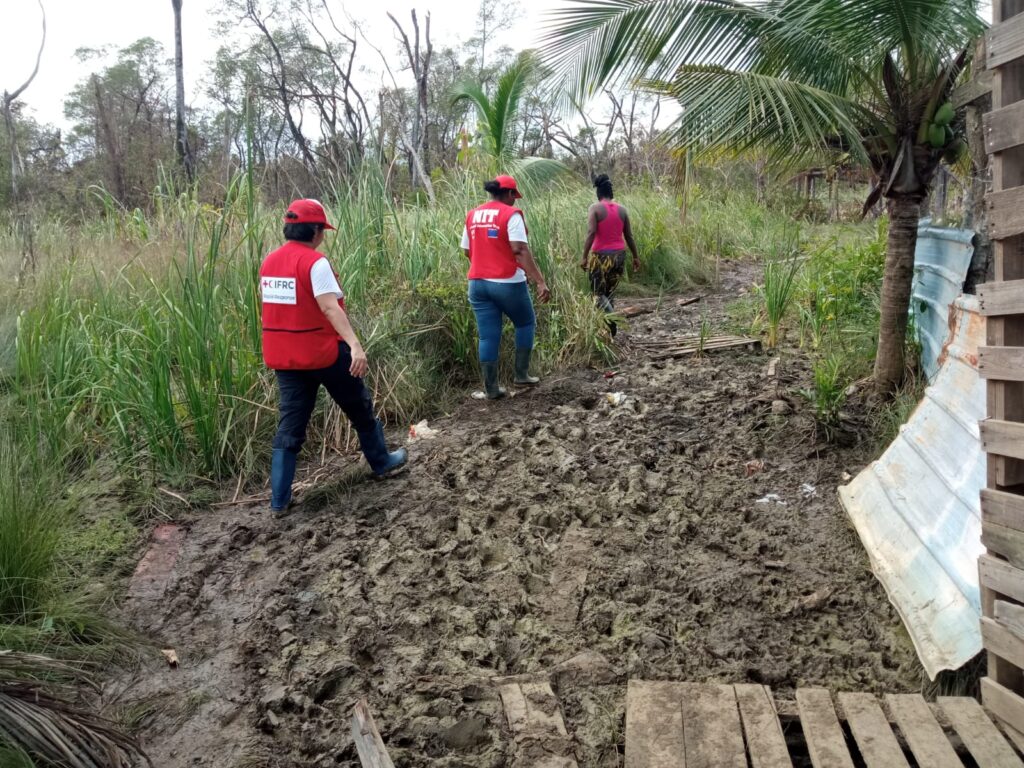
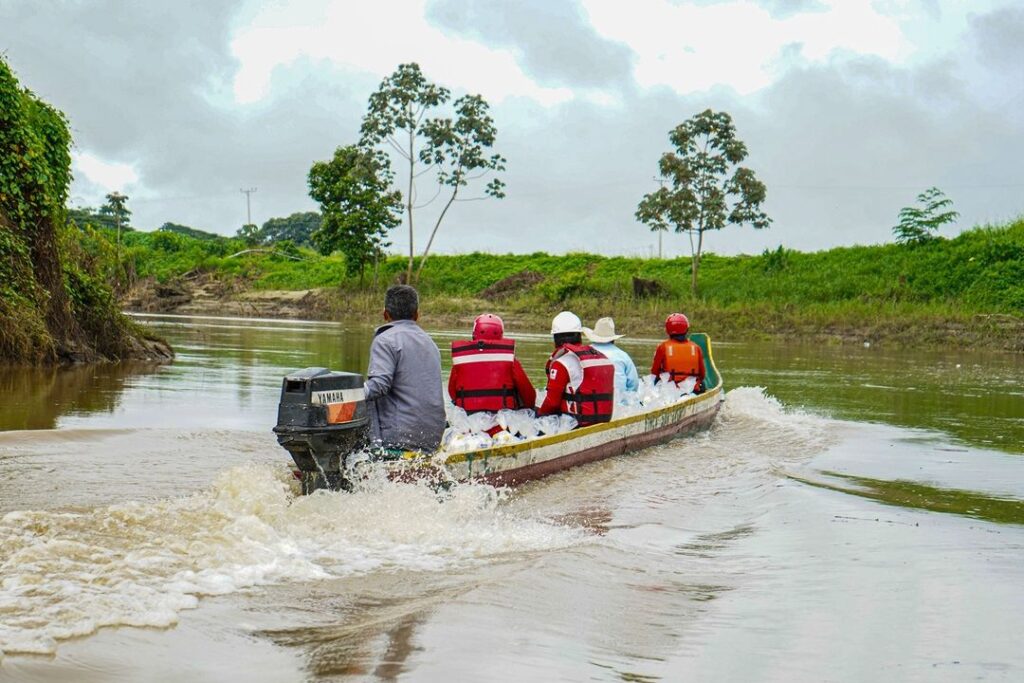
Surge Capacity: Harnessing the power of our global network
The goal of the surge initiative is to enhance the capacities to respond to emergencies.
The Rapid response system is open for any member of the Red Cross and Red Crescent movement with the capabilities to deploy immediately to support a wide range of activities, including emergency assessments, coordination, analysis, planning and implementation.
Surge capacity is built on a competency-based approach, which includes a core competency framework and technical competencies.
The Rapid Response Management System is a global platform which includes a catalog with the standard profiles needed for the different areas of the Emergency Response units. On the platform you can register, receive alerts, apply, receive training information, reports, etc.
Process of deployment consists of four steps:
- The NS and the IFRC identify roles needed according to the categories in GO
- The alert is issued in the system via email.
- 24 to 48h period to receive applications
- Potential candidates are identified, evaluation is done and a decision is made. Some of the criteria to select the right person are proximity, language, core and technical competencies, immediate availability, gender balance, among others.
Highlights from experiences of rapid response personnel:
- Each deployment is unique and a significant experience.
- When there are not many people deployed, those deployed are involved in several areas.
- The advantage of being a member of the roster is that you receive alerts directly.
- The surge personnel support the development of installed capacities to the NS.
The Dominican Republic Red Cross shared good practices and the advantages of receiving surge personnel specializing in Community Engagement and Cash assistance. For instance, they now have clear protocols and written documents to implement activities in these two areas.
Finally, the surge team acknowledged that, despite the efforts made, achieving gender balance on the deployments is still a challenge in the region.
Working together to mobilize early funding for early warning and action
The Strategic Partnerships and Resource Mobilization session had representatives from the IFRC, UNDRR, ECHO and looked at the importance of investing in preparedness, anticipatory actions and early alerts.
The IFRC is part of the Early Warnings for All (EW4All) initiative 2023-2027 with responsibility for pillar four – preparedness to respond, which focuses on anticipatory actions and early warning systems. For the IFRC it is a priority to increase anticipatory actions however there are financing gaps, as over 50 million dollars is required for the intervention overall.
A structural problem in the region which needs to be addressed is the use of information to make informed decisions. There also needs to be strengthening the early alerts system which is currently being addressed through the EW4All initiative.
Misinformation or fake news is also a major challenge which needs to be addressed as it sometimes influences decision makers. There needs to be more accountability especially from relevant authorities to ensure they share accurate information. There will always be a margin of uncertainty, but this margin of error is better than not using the information to do anything at all, as anticipatory action requires information to act.
The UNDRR is also part of the EW4All initiative and is leading pillar one which has to do with disaster risk knowledge, however there are significant gaps in terms of risk information and assessments. Sometimes the issue is not having the information, as the information might exist but there is a lack of financing to use that information to take required actions.
The European Union is committed to scaling up funding of anticipatory action and has been involved in several spaces where this is being discussed. At the global level, they are rolling out some pilot initiatives to test different approaches. There are more than 20 projects on anticipatory action worldwide and there are also tools which can help test e.g. class modifier. Based on the outcomes of these pilots, it will be determined what could turn into long term initiatives.
There is growing interest in funding anticipatory actions however one of the key components is coordination, to ensure that not only is there scaling up of anticipatory actions but that it is done in a coherent manner and involves all the key players including government, UN agencies, etc. However humanitarian aid cannot be the only source for anticipatory actions.
Logistics and supply chain: How to deliver high-quality humanitarian assistance on time, in the right quantity and at the right price
The IFRC is a recognized provider of global humanitarian supply chain services – both to members of the International Red Cross and Red Crescent Movement and to humanitarian organizations and governments around the world. It provides a wide range of logistical support to our global humanitarian network, ensuring that our members can respond quickly and effectively before and after disasters.
The IFRC’s services include procurement, warehousing, transportation and support to our members. All are focused on a single objective: to get quality humanitarian aid to the people most affected by disasters, in the right time, quantity and price. In other words, our goal is to get aid to people as quickly as possible, avoiding shortages and waste, and getting the best value for money.
The IFRC has warehouses in three strategically located regional logistics hubs – Dubai, Kuala Lumpur and Panama – as well as sub-regional prepositioned stocks to support hard-to-reach areas and disaster-prone locations.
In the Americas, pre-positioned medical and non-food supplies for up to 20,000 people can be rapidly delivered within 48-72 hours of a disaster. An additional 60,000 people can be successfully assisted in the 15 days following a disaster.
We have pre-positioned supplies in Panama, Honduras, the Dominican Republic, Argentina, Trinidad and Tobago, and Jamaica. These items include tents, blankets, tarps, mosquito nets, buckets, first aid kits, hygiene kits, kitchen sets, water and sanitation supplies, and vehicles.
Our warehousing and handling services include unloading, storage, packing, repacking, labeling, kit preparation, order consolidation and transportation. We also provide vehicle procurement and fleet management services, including improving National Societies’ fleet capacity and developing drivers’ skills in areas such as road safety.
In general, we help National Societies better understand their logistics needs and identify gaps in their current systems. We can help them design logistics development plans and provide technical support for their implementation.
This session also introduced us to a new tool: the Stockholm Platform https://esups.org/our-work/stockholm-platform/ This website allows users to explore the current levels of humanitarian stocks in every country in the world. The data provided by the platform includes Red Cross and Red Crescent stocks, as well as those of other organizations.
Legislation is essential to ensure the effectiveness of early warning systems and forecast-based actions
The Disaster Law session featured representatives from the Caribbean Meteorological Organisation, the Belize Red Cross and the IFRC.
The Caribbean Meteorological Organisation (CMO) which originated in 1951, now serves as an umbrella organisation for the Caribbean Meteorological Council and the Caribbean Meteorological Service and Institute.
The Caribbean is one of the most hazard-prone regions in the world, as such there is a need for multi hazard early warning systems in the Caribbean. There is also the need for accurate and timely weather, climate and environmental information and effective integration and application of that information.
However, multi hazard early warning systems need to be underpinned by legal and governance frameworks. CMO supports governance and institutional arrangements, unfortunately, many CARICOM member states’ national meteorological organisations do not have legislations that address their existence and operations. As such, there is a need for appropriate legal mandate, with well-defined roles, responsibilities, adequate resources and interactions with other agencies.
There is also the need to strengthen the regional and national systems related to weather, climate and water services, multi hazard impact-based forecast and warning and service delivery for enhanced decision-making.
The Belize Red Cross shared their experience during Hurricane Lisa with operational challenges faced, specifically disaster response coordination. While the national society generally tried to include the national disaster organisation in its coordination, planning and assessment, and tried to share relevant information, they found that there was no mutual partnership and their efforts at coordination were seldom acknowledged or reciprocated. This resulted in duplications in assessments conducted and relief distributed, causing unnecessary costs and undue delays by having to return to the affected communities.
For other aspects of the response, such as distribution of cash vouchers and food packages, there were several disparities, as community members received vouchers and packages with varying amounts from different organisations. There were also delays and additional challenges to both cleaning and sanitation activities as well as initial assessments due to lack of coordination among government infrastructure and public works entities for fast clearance of access and waterways.
It is recommended that to save time and resources, communication among partners should be open, accurate, clear, timely and factual to allow smooth and effective implementation of mutual interventions. In addition, there should be a standardisation in how relief is distributed (what, how, when, by whom and to whom) to avoid future problems.
Following the experiences gained from Hurricane Lisa, the partnership with the national disaster office has improved significantly. They have been revising and updating operational and disaster plans, strategies, and other guiding documents with increased focus on improving and strengthening the capacity of vulnerable communities in collaboration and coordination with partners, like the Belize Red Cross, which is already working in the field.
In addition, in October 2023, the Belize Red Cross signed an MOU with their national disaster office promoting a spirit of close cooperation through regular consultations on matters of common interest as well as encouraging partnerships and participation in issues of mutual interest. The MOU also includes cooperation in strengthening community resilience in Belize in several areas including Disaster Management, Disaster Risk Reduction and Climate change, Disaster Law, Health in Emergencies, Disaster Relief and Emergency Response and Gender and Youth. The Belize Red Cross will also be sensitising government agencies in IDRL.
This experience has underscored the importance of how both the government and the Red Cross can benefit from improved coordination, clearer lines of communication and a better understanding of each organisation’s mandates, principles, and values.
In the last presentation of the session, the IFRC shared the international disaster risk governance guidelines. Disaster risk governance includes various subsets such as disaster risk reduction, preparedness and response, recovery, international disaster response law, public health emergencies and protection and inclusion.
The disaster risk governance guidelines are designed to support states in their efforts to strengthen disaster risk governance and become legally prepared for disasters. They are a benchmarking tool (best practices) that can be used to guide the development and review of domestic instruments.
For early warning and early action to be successful, law, policies and plans should mandate and allocate responsibility for each of the key components of an early warning system and establish standards for the content, presentation and dissemination of warnings. They should also mandate contingency plans to address not only response but also early actions and identify the trigger for early actions as well as what happens when the trigger occurs. Finally they should mandate and allocate responsibility for evacuation planning (people, pets, livestock).
Is your National Society ready to step up its humanitarian response through engaging and robust public communications?
Panelists reviewed the role of public communications in emergencies, including: storytelling and content production; press management; reputational risk management; support for resource mobilization and community engagement activities; and strengthening communications capacity at the local and national levels.
They then discussed the importance of storytelling in raising awareness of humanitarian needs, upholding core principles, amplifying the voices of communities and advocating for their needs to be met, among other things.
They also presented a checklist that national and local Red Cross teams can complete to determine their level of preparedness for public communications. This checklist includes basic requirements they should have in areas such as planning and funding, human resources, content production and approval protocols. This checklist, as well as a communications skills self-assessment guide, is available for those who wish to complete it before the season begins.
Regarding content creation, the comms team shared 7 key tips to keep in mind when telling stories:
- Humanity, dignity and people’s voices are at the heart of our storytelling.
- The stories we produce must be as plural and diverse as the communities we work with. We must include as many voices as possible: women, children, the elderly, people with disabilities, etc.
- Ethics guide our communications; we must adhere to the code of conduct and respect people’s right to choose whether or not to tell their story. WE MUST ALWAYS HAVE INFORMED CONSENT.
- Let’s use the voices of the Red Cross, more and more people trust the media less and less than their peers.
- Let’s avoid the excessive use of data, it is easier to remember single digits and it is always better to accompany them with emotions.
- Facts and data do not change mentalities, emotions do.
- Let’s be aware of the potential, limitations and biases of AI.
Finally, the panelists reminded that they are always available to support National Societies, review their communication capacities and identify areas for improvement. They also shared useful resources to prepare before the season: content libraries, repository of images and videos, templates to develop key messages, communication plans, guides to generate content, among other useful tools that can be accessed publicly.
Operational safety in emergencies: Recognizing our fragility and learning from humanitarian operations in sensitive and complex contexts
Red Cross staff and volunteers do everything they can to save lives and bring relief to those in need. But like all human beings, these people are vulnerable and exposed to risks: accidents, violence, stress.
More and more emergencies and disasters are occurring in communities affected by insecurity and violence. A good example is Hurricane Otis, which hit areas of Mexico where security conditions make it difficult to access the most affected communities.
Working in such sensitive contexts, National Societies need to understand how they are perceived and increase their level of acceptance, safety and access to people and communities in need. To achieve this, they rely on the Safer Access Framework, a set of actions and measures based on their Fundamental Principles and other Movement policies to help them mitigate the risks they face.
These measures are often straightforward to implement and address context and risk analysis, legal frameworks and policies, organizational and individual buy-in, internal and external communication and coordination, and operational risk management. These elements are like links in a chain: interconnected and interdependent.
In September 2023, Otis made landfall in Guerrero, a state with a presence of armed civilian groups and home to subversive groups. To respond, the Mexican Red Cross implemented the Safer Access Framework and operational risk management tools, all with two objectives: to look after volunteers above all else, and to identify acceptable risks. Six lessons were learned from this operation:
Mastering operational communications is critical. Access to communities to deliver aid depends on our ability to explain who we are, what we do and don’t do, and how and with whom we do it.
Adapting our tools and experiences is key. No two emergencies are the same, let alone those in complex contexts such as this, which require tailored solutions.
Safe distributions protect volunteers and communities. This includes carefully preparing logistics, identifying the distribution area, inspecting it before distribution begins, anticipating crowds, and conducting controlled deliveries.
Visibility must be maximized. Personnel, vehicles, and facilities must be identifiable. Use of the emblem makes a difference.
The mental health of volunteers must be a priority. In the disaster response cycle, tensions in affected communities rise within two weeks of a shock, just as volunteers’ ability to cope with stress tends to decline. Therefore, staff and volunteer rotation is critical and cannot be overlooked.
The scenes, emotions, and situations we experience during an emergency stress us and push our minds to the limit. Stress can cause us to make poor and dangerous decisions, which is why investing in mental health is essential. It is essential to invest in training, simulations, therapy sessions, and emotional preparation before disasters occur so that we can respond in a safe and effective manner that respects the dignity of the crusaders themselves.
Anticipatory action and early warning systems: The Red Cross experience in Jamaica, Mexico and Ecuador
In the Americas region, 14 Red Cross societies are involved in anticipatory actions and some have already drafted plans on this subject. In 2023, most of these plans were for flooding and drought. Over 6000 persons were trained in anticipatory action and over 4,600 families received humanitarian assistance.
The Jamaica Red Cross shared how they have been working with communities to strengthen anticipatory actions at the local level and highlighted four key components that are critical in facilitating effective anticipatory actions and early warning and actions.
- Community disaster response teams (CDRT) – Early actions are better led by communities and need to be included in the community disaster risk management process. CDRTs need to be effective, well trained and engaged. Dormant CDRTs must be revived and re-engaged and where there are gaps, new CDRTs can be formed.
- Effective partnerships – Forming partnerships at the local level with governmental and non-governmental agencies is critical to strengthening early actions and early warnings.
- Well trained staff and volunteers – This is a gap that has been identified however the JRC is working to ensure that its staff and volunteers are trained in anticipatory actions to support communities.
- Adequate funding – Helps to ensure we have effective early warning systems which are tailored based on the expected risks, for example, in Jamaica, most communities are affected by flooding and land slippage. The JRC is also seeking opportunities for capacity building and funding from within and outside the Red Cross movement.
Overall, it is important to ensure that communities are knowledgeable of their risks and how to implement anticipatory actions to address these risks.
The Mexican Red Cross shared some reflections on how they experienced the impact and response to Hurricane Otis last October. In a matter of hours, Otis quickly went from a tropical storm to a category five hurricane, so there was little time to monitor the intensity and issue a warning.
Upon arriving at the affected zone, the Red Cross assistance was concentrated on resolving the first needs of the population, such as food, shelter, water and sanitation. However, people affected questioned why they were not alerted on time about the life-threatening impact of Otis. According to the last warning issued before it landfell, reported that Otis was a category three hurricane, similar to others that impacted the area in the past. However, Otis did hit as a major hurricane. If early warnings do not reach the population updated and on time, no system can be effective, even if we have adequate tools and forecasts.
The Mexican Red Cross also shared how they have worked on improving the early warning system through the development of a community resilience study, analysis of vulnerabilities and capacities, and the identification of areas of opportunity for collaboration between different sectors.
They are currently developing actions to expand Early Warning Systems through community engagement activities, implementation of local monitoring methods, and community planning based on the adaptation of national strategies.
The Honduran Red Cross shared how they went from having institutional plans for anticipatory action to having them adopted by government institutions and communities, who are the first responders to emergencies.
During 2023, they were able to create a technical advisory group for anticipatory action with different governmental and non-governmental institutions. They developed the first global human mobility Early Action Protocol (EAP), a drought EAP and a tropical storm EAP. They have participated in the establishment of municipal emergency committees and local emergency committees that have received training in early action.
In the framework of the Programmatic Alliance between the IFRC and the European Union, they are developing an Early Action System for one of the most flood-prone sectors in the Northern Zone, the Sula Valley, a sector that has become more vulnerable since the impact of hurricanes Eta and Iota. This plan aims to ensure that, 10-15 hours before the emergency, the response teams in the communities already have the forecasts that allow them to be prepared. Currently, they receive them three to five hours before the possible event.
Finally, the Ecuadorian Red Cross shared their experience in developing EAPs for rains related to the El Niño phenomenon in the coastal zone. Some of the most important actions taken in the EAP were the training of volunteers and staff, the pre-positioning of supplies and the pre-assistance to the communities to be affected.
Since 2017, they have been working on the topic of early warning and action in coordination with different government actors, trying to ensure that anticipatory actions are not seen as part of the response, but as a previous step. A major achievement is the inclusion of anticipatory action in the Risk Management Law, recently approved.
The challenge for the Ecuadorian Red Cross has been to rely on forecasting. They had to learn how forecasting works, how to get the data, and how to incorporate it into preparedness activities.
One of the key elements in the EAP development process is to work closely with technical-scientific organizations to continuously improve forecasts to increase community confidence. Equally important is working hand in hand with communities and local stakeholders in the construction and validation of the plan.
Preparedness for effective response: Two simple ways to put the PER mechanism in place before the hurricane season starts
The IFRC introduces the National Society Preparedness for Effective Response (PER) strategy to bolster National Societies in fulfilling their auxiliary role and vital support role during crises. PER, an evolved approach building on two decades of insights, focuses on five key areas: policy and standards, analysis and planning, coordination, operational capacity, and operations support. This comprehensive framework offers guidance for a robust disaster preparedness mechanism.
PER facilitates systematic evaluation of response systems, enabling National Societies to identify strengths, weaknesses, and actionable plans. Through seasonal preparedness checks, one of PER’s tools, National Societies can assess their response capacities, pinpointing areas needing support and immediate actions to enhance effectiveness.
This check aims at documenting lessons from past responses aids in refining future strategies. This way, National Societies can swiftly identify, for instance, areas for improvement and resource requirements, be it financial or rapid response teams.
Methodologically, the list can be run in a full-day session engaging response teams and other units, and posing queries like, “Is the current benchmark status adequate?” or “Are operational components sufficient?” The outcome includes critical short-term actions, and solutions devised for capacity constraints within tight timelines.
The Belize Red Cross Society applied this tool in 2023, when they held a pre-hurricane season meeting. As a result, they identified self-care needs and signs of burnout in volunteers, how to identify each crusader’s experience and actions to take to improve safety in the field.
If the “Seasonal Preparedness Check” is to be used before disasters, the PER has other tools that can be used in the first hours after a shock. One of these is the Rapid Response Capacities Check. Its purpose is to identify areas where the operation has gaps that could pose a risk. It is a very short checklist consisting of 19 questions divided into the five areas of the PER approach. Each of them should be answered with one of three options: There is no barrier in this area, this area requires immediate action to address a gap, or this area requires some corrective action.
Methodologically, this tool can be used by the operations or disaster response manager. It can be completed in two to three hours and its results can radically improve emergency response.
The Costa Rican Red Cross shared the lessons learned after they conducted the PER evaluation. Despite the initial anxiety about the potential results, they consider it paramount to identify the areas to be strengthened. This National Society has undertaken two PER evaluations and the level of improvement from one to the other is tangible.
PER empowers National Societies to proactively strengthen their response mechanisms, ensuring timely and effective humanitarian aid. Through strategic evaluation and collaborative planning, PER fosters resilience in the face of crises.

